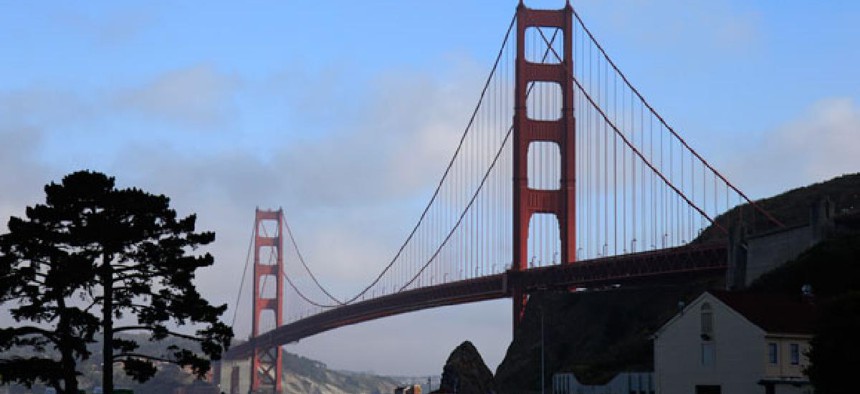
Fort Baker abuts the Golden Gate Bridge. Eric Risberg/AP
Analysis: Lessons from a reinvented military base
The transformation of obsolete military facilities can occur anywhere.
The gunners, the "guardians of the gate" as they were known, must have felt like they were in a dream. Manning batteries along the rumpled Marin Headlands on the north side of the Golden Gate Strait, they were on the lookout for Japanese warplanes and submarines threading though the mines they had laid, all amid breathtaking natural beauty – the rolling Pacific, the cascading white fog invading the San Francisco Bay. They were Homeland Security a half-century before September 11, sentinels of a threat that would never come.
In the evenings they would return to Fort Baker, the military post by a crescent-shaped cove at the base of the Golden Gate Bridge, a collection of officers quarters and barracks arrayed around parade grounds overlooking Alcatraz and the city of San Francisco to the south. The strategic importance of the site was clear early on, designated in 1850 by President Millard Fillmore as a military reservation that mirrored the Presidio across the water. Both had commanding views of the only opening from the Pacific to San Francisco Bay, and both became urban villages, with everything from a hospital to a blacksmith to a bakery. After World War II, Fort Baker hosted administrative offices for reconnaissance and the Nike missile sites of the Cold War, but by the end of the 20th century the strategic necessity had come and gone, replaced by computers and satellites. Fort Baker, named for a Civil War hero, was abandoned, and the military turned the property over to the National Park Service, as part of the Golden Gate National Recreation Area.
Residents of nearby Sausalito went for jogs and walked their dogs amid the empty buildings, but this was a special place that cried out for reinvention. The story of how this urban asset was re-purposed holds lessons for cities engaged in similar transformations.
In 1989, the Bay Area Discovery Center opened at the water’s edge, and the last property holdings were turned over in 2002. An early proposal for a 350-room hotel and conference center was greeted in somewhat typical Bay Area fashion with loud opposition and concerns about traffic. Then Equity Community Builders and Ajax Capital Group LLC partnered with Passport Resorts, operators of the luxury Big Sur resort the Post Ranch Inn, to engineer a kinder and gentler intervention – Cavallo Point Lodge, a 142-room hotel in rehabilitated Colonial Revival structures and a collection of new buildings on existing foundations, a $100 million project that combined historic preservation and green building.
The 28-acre resort, which opened in 2008 with spa, conference rooms, cooking school and Michelin-rated restaurant, is not inexpensive. The white-clapboard and red-roofed military buildings, most of them dating back to 1901 to 1910, have the feel of an elite college campus, set amid the Monterey pines planted as wind breaks, and the rye grass that is not cut but instead allowed to grow long. The view from the front porches is nothing if not serene. But going for high-end quality is what made this retrofit work. It is hard to imagine anything else being there, a tasteful and elegant re-use that somehow captures the site’s history as a military facility. The parade grounds remain entirely open to the public, and the resort offers discounted rates to environmental non-profits holding meetings there.
The developers took advantage of $10 million in federal historic preservation tax credit financing, won LEED Gold certification, and secured a long-term lease from the National Park Service, similar to the Awhanee Hotel in Yosemite. Across the bay, the Presidio is undergoing a similar transformation, the site of movie studios, museums, hiking trails, restaurants, academic institutions such as the Presidio Graduate School, and residential redevelopment. Nearby Crissy Field, site of the wartime air strip, has also been famously re-imagined as a landscaped urban open space.
Yes, this is red-hot San Francisco, throbbing with economic activity spearheaded by Apple, Google, Twitter, and Facebook. The resources are abundant for these kinds of projects, and they join the slipstream of economic well-being – similar to another celebrated repurposing of old infrastructure, the High Line in New York City. Yet the transformation of obsolete military facilities or old mill buildings and factories can occur anywhere. In Massachusetts, the contemporary art museum MassMOCA has been a lift for North Adams; Fort Devens and the South Weymouth Naval Air Station are being redeveloped.
Can any city do this? I would argue yes, and that the repurposing of these assets and infrastructure can continue to be a cornerstone of economic development. This year’s Cleveland Design Competition is collecting ideas to re-imagine the abandoned lower streetcar level of the Detroit-Superior Bridge as a new public space, performance venue and pedestrian experience. The ambitions are a bit High Line-like, but so be it. Part of the secret may be aiming high.
---
Anthony Flint is a fellow at the Lincoln Institute of Land Policy, a think tank in Cambridge, Mass., and author of Wrestling With Moses: How Jane Jacobs Took On New York’s Master Builder and Transformed the American City and This Land: The Battle Over Sprawl and the Future of America. His next book, The Raven: The Life of Le Corbusier, Maker of the Modern will be published in the fall of 2014 by Amazon Publishing.






